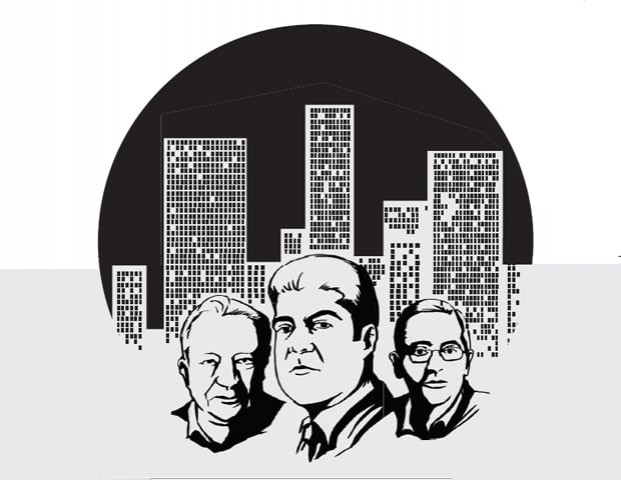Debate: Does Karachi need more high-rise buildings?
The experts slug it out over this question that affects us all

A high-rise building was planned next to Karachi Grammar School in Clifton but after pressure was applied, the authorities shot it down. Just a stone’s throw away, though, permission was granted for several other high-rise projects. Given these developments, experts Roland deSouza of NGO Shehri and architect Arif Belgaumi gave a public presentation on the new Sindh high density law, which affects, among other areas, a large portion of Clifton.
Everyone understands that Karachi’s density is increasing, even though we may not have enough water or electricity to go around. Density is driven, in part, by a need for housing. The opposite of density is sprawl. And indeed, Karachi has spread out. But this just makes it harder for people living on its periphery to commute to work in the centre of the city. It would appear that density is inevitable and desirable for Karachi. But when we look at katchi abadies or unplanned, informal settlements such as Delhi Colony, Neelam Colony, Akhtar Colony, we do ask if this is the kind of density that works for people.
After the public presentation on the new law designating high-density zones, which The Express Tribune published on July 8, a debate was started by Lahore-based urbanist Ahmad Rafay Alam. In this five-part series, The Express Tribune brings him together with two urban experts who candidly ask whether Karachi needs more high-rise buildings or density and if so, how.
Q: Rafay Alam

Lawyer, environmentalist and activist
Isn’t density something that we want in cities? Why is there a problem [developing] it in DHA? The urban elites live in planned low-density, and it eats up the resources of the rest of the city.
A: Arif Hasan

Architect & planner, activist, teacher, social researcher & writer
We already have density. Karachi is the third most dense city in the world after Dhaka and Mumbai. Its density is 2,800 per persons per hectare. The maximum density permissible according to byelaws is 1,625 for low-income apartments. This higher-than-prescribed density is because Karachi’s poor settlements, especially the lower-middle class high-rises in the city centre, have unplanned densities of well over 5,000 persons per hectare, resulting in serious over-crowding which creates environmental and social problems which have been well-documented. The problem, as Rafay Alam has pointed out, is the low densities of the higher income groups. Houses of between 400 to 2,000 square yards are only 2% of the total housing stock in the city but occupy 31% of residential land. Regarding densification of areas like M.A. Jinnah Road, Mai Kolachi etc. I have no problems with it except for issues related to transport and traffic. Water and sanitation are manageable but transport and traffic requires proper urban design exercises which cannot be only area-specific and have to deal with the city as a whole.
A: Arif Belgaumi

Practising architect and teaches architectural design at the Indus Valley School of Art and Architecture
In recent years the word density has been tossed around quite liberally as the solution to Karachi’s sprawl. Karachi may have the potential to sprawl but that potential is still largely unrealized. In fact, Karachi is the third densest city in South Asia with an average density of 2,800 persons per hectare, behind Dhaka, 4,400 persons per hectare and Mumbai, 3,200 persons per hectare. This is largely due to the numerous katchi abadis which house more than half the population of the city. If we pursue an agenda of densification in the more spacious areas of the city then we should also be working to de-densify the katchi abadis and colonies that dot the city. A sustainable middle ground needs to be found.
Secondly, the word densification is used synonymously here with high-rise development. One extreme condition, single-family housing, does not need to be replaced with another extreme, multi-family high-rise construction. Only the economic imperative of maximising profits suggests the need for high-rise development. If an area of single-family housing is converted into four- to six-story apartment or office blocks, it may be dense enough to contain sprawl, not tax the urban infrastructure, retain a human scale to the city and preserve the sense of community which is impossible to achieve with soaring high-rises. Many of the most attractive cities of the world, Paris, Barcelona, Berlin, London, Istanbul have maintained this scale of construction.
Incidentally, the area identified by the Sindh High Density Development Board for densification also include already dense katchi abadis like Shireen Jinnah Colony, Sultanabad, Machchar Colony, the Mauripur waterfront and Lyari, leading one to suspect opportunities for large-scale real estate speculation.
Meanwhile, escalation in land prices has already created an economic impetus for densification. It is now common practice for people with large plots to bifurcate them and sell one half to finance the house. It is only a matter of time before DHA begins to allow denser development of plots.
Published in The Express Tribune, September 15th, 2014.


















COMMENTS
Comments are moderated and generally will be posted if they are on-topic and not abusive.
For more information, please see our Comments FAQ